BMW Z4 3.0I COUPE 2007 E86 Owner's Guide
Manufacturer: BMW, Model Year: 2007, Model line: Z4 3.0I COUPE, Model: BMW Z4 3.0I COUPE 2007 E86Pages: 132, PDF Size: 3.14 MB
Page 31 of 132
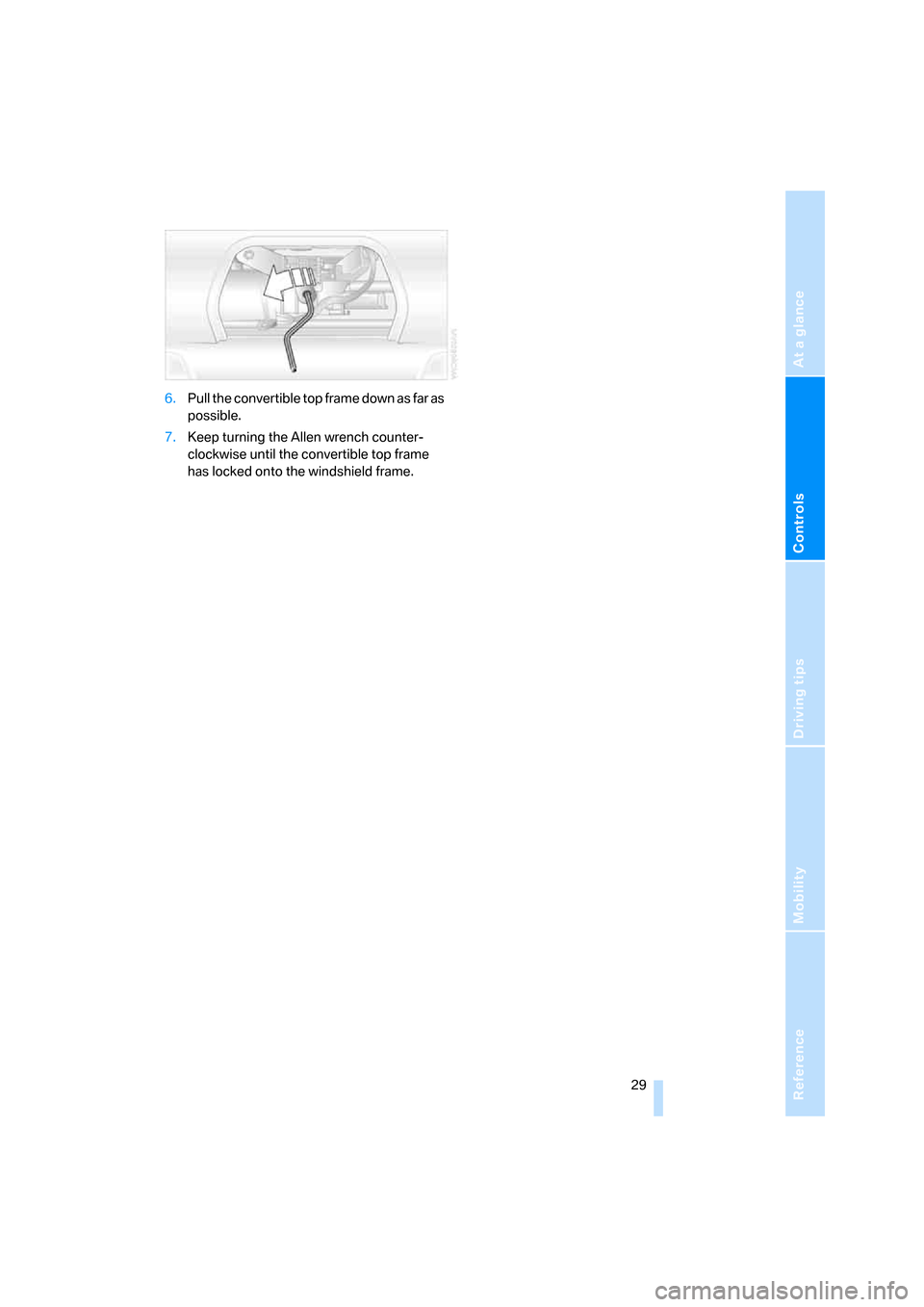
Reference
At a glance
Controls
Driving tips
Mobility
29
6.Pull the convertible top frame down as far as
possible.
7.Keep turning the Allen wrench counter-
clockwise until the convertible top frame
has locked onto the windshield frame.
Page 32 of 132
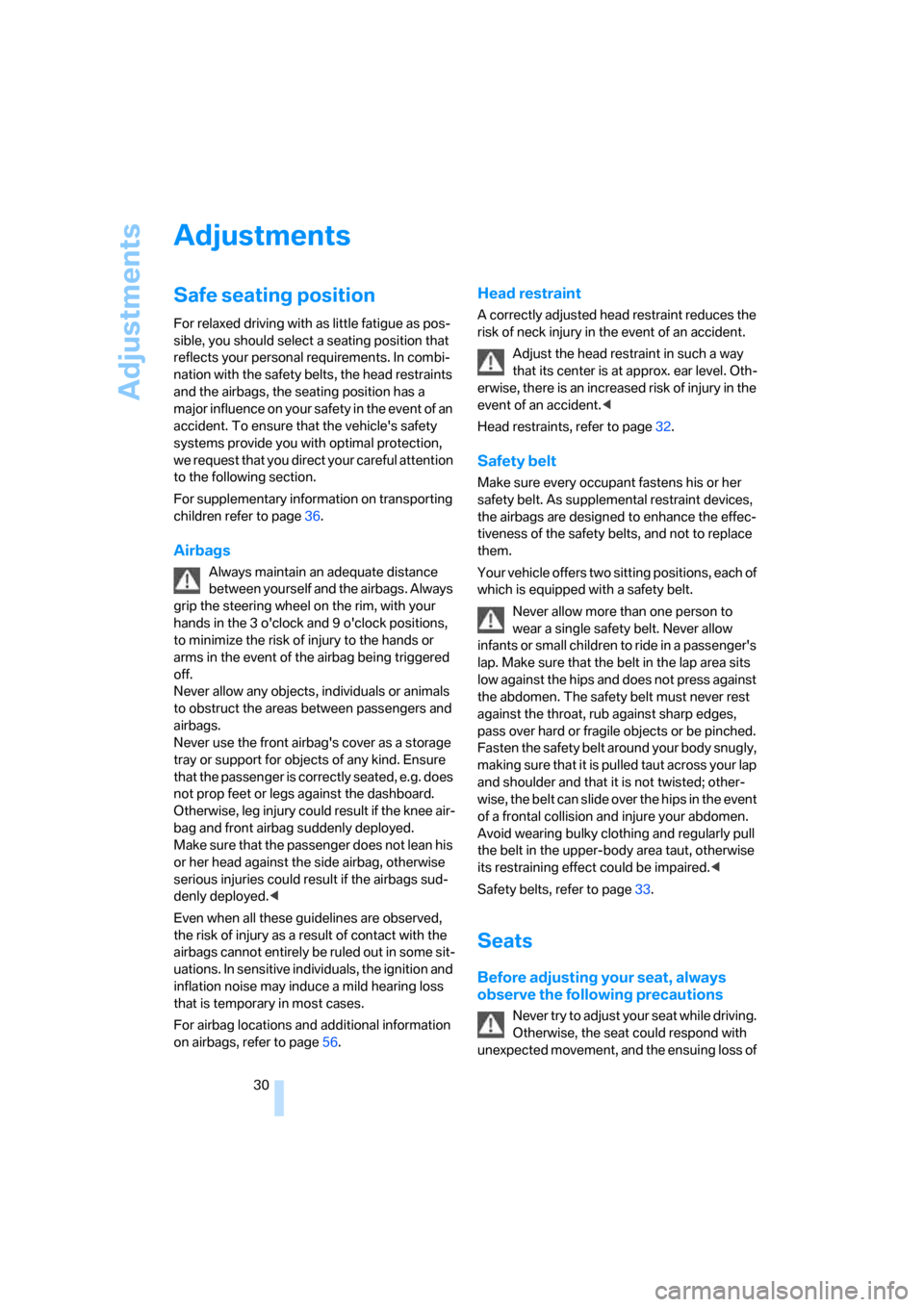
Adjustments
30
Adjustments
Safe seating position
For relaxed driving with as little fatigue as pos-
sible, you should select a seating position that
reflects your personal requirements. In combi-
nation with the safety belts, the head restraints
and the airbags, the seating position has a
major influence on your safety in the event of an
accident. To ensure that the vehicle's safety
systems provide you with optimal protection,
we request that you direct your careful attention
to the following section.
For supplementary information on transporting
children refer to page36.
Airbags
Always maintain an adequate distance
between yourself and the airbags. Always
grip the steering wheel on the rim, with your
hands in the 3 o'clock and 9 o'clock positions,
to minimize the risk of injury to the hands or
arms in the event of the airbag being triggered
off.
Never allow any objects, individuals or animals
to obstruct the areas between passengers and
airbags.
Never use the front airbag's cover as a storage
tray or support for objects of any kind. Ensure
that the passenger is correctly seated, e.g. does
not prop feet or legs against the dashboard.
Otherwise, leg injury could result if the knee air-
bag and front airbag suddenly deployed.
Make sure that the passenger does not lean his
or her head against the side airbag, otherwise
serious injuries could result if the airbags sud-
denly deployed.<
Even when all these guidelines are observed,
the risk of injury as a result of contact with the
airbags cannot entirely be ruled out in some sit-
uations. In sensitive individuals, the ignition and
inflation noise may induce a mild hearing loss
that is temporary in most cases.
For airbag locations and additional information
on airbags, refer to page56.
Head restraint
A correctly adjusted head restraint reduces the
risk of neck injury in the event of an accident.
Adjust the head restraint in such a way
that its center is at approx. ear level. Oth-
erwise, there is an increased risk of injury in the
event of an accident.<
Head restraints, refer to page32.
Safety belt
Make sure every occupant fastens his or her
safety belt. As supplemental restraint devices,
the airbags are designed to enhance the effec-
tiveness of the safety belts, and not to replace
them.
Your vehicle offers two sitting positions, each of
which is equipped with a safety belt.
Never allow more than one person to
wear a single safety belt. Never allow
infants or small children to ride in a passenger's
lap. Make sure that the belt in the lap area sits
low against the hips and does not press against
the abdomen. The safety belt must never rest
against the throat, rub against sharp edges,
pass over hard or fragile objects or be pinched.
Fasten the safety belt around your body snugly,
ma king sure tha t it is pulled taut across your lap
and shoulder and that it is not twisted; other-
wise, the belt can slide over the hips in the event
of a frontal collision and injure your abdomen.
Avoid wearing bulky clothing and regularly pull
the belt in the upper-body area taut, otherwise
its restraining effect could be impaired.<
Safety belts, refer to page33.
Seats
Before adjusting your seat, always
observe the following precautions
Never try to adjust your seat while driving.
Otherwise, the seat could respond with
unexpected movement, and the ensuing loss of
Page 33 of 132
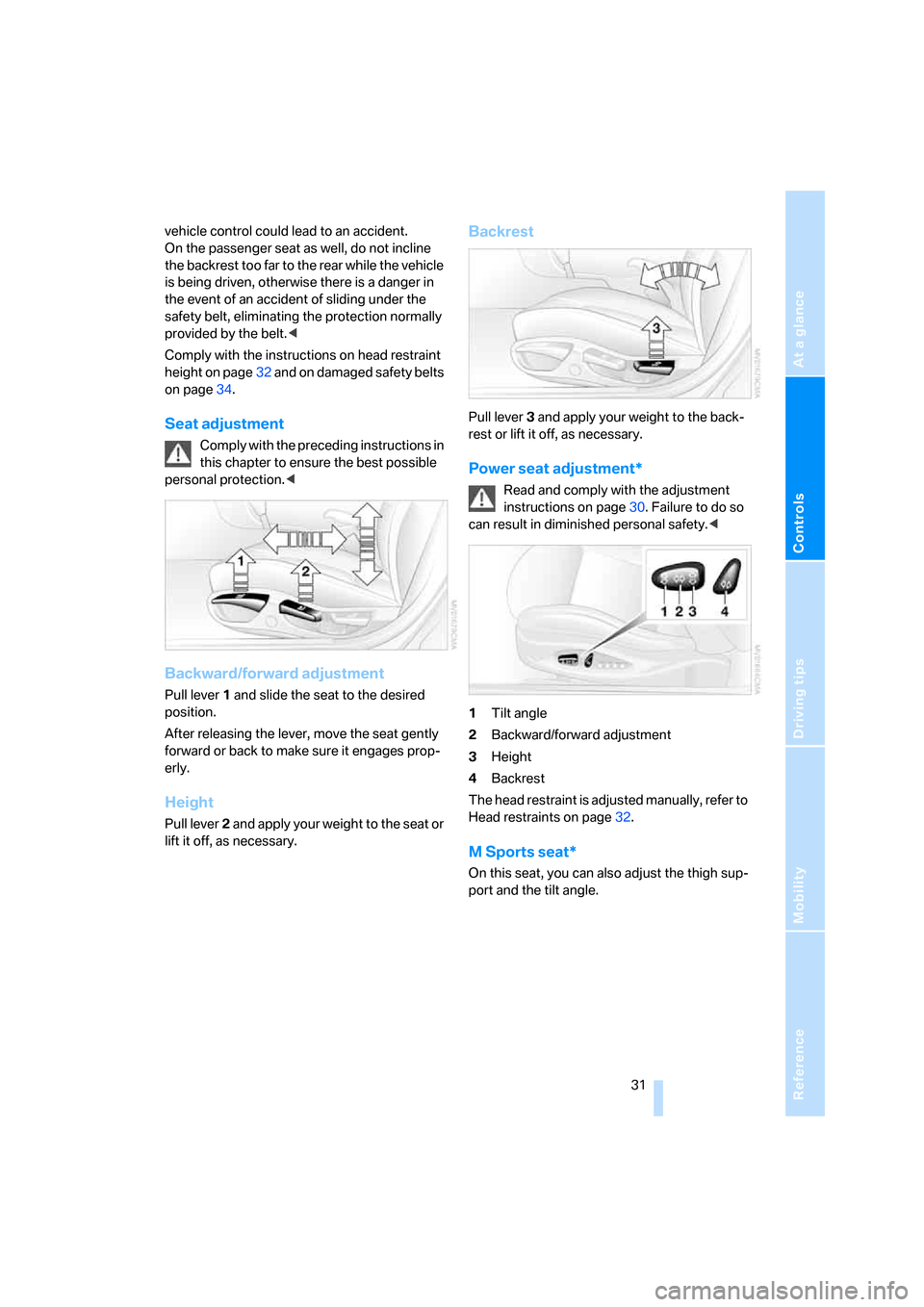
Reference
At a glance
Controls
Driving tips
Mobility
31
vehicle control could lead to an accident.
On the passenger seat as well, do not incline
the backrest too far to the rear while the vehicle
is being driven, otherwise there is a danger in
the event of an accident of sliding under the
safety belt, eliminating the protection normally
provided by the belt.<
Comply with the instructions on head restraint
height on page32 and on damaged safety belts
on page34.
Seat adjustment
Comply with the preceding instructions in
this chapter to ensure the best possible
personal protection.<
Backward/forward adjustment
Pull lever 1 and slide the seat to the desired
position.
After releasing the lever, move the seat gently
forward or back to make sure it engages prop-
erly.
Height
Pull lever 2 and apply your weight to the seat or
lift it off, as necessary.
Backrest
Pull lever 3 and apply your weight to the back-
rest or lift it off, as necessary.
Power seat adjustment*
Read and comply with the adjustment
instructions on page30. Failure to do so
can result in diminished personal safety.<
1Tilt angle
2Backward/forward adjustment
3Height
4Backrest
The head restraint is adjusted manually, refer to
Head restraints on page32.
M Sports seat*
On this seat, you can also adjust the thigh sup-
port and the tilt angle.
Page 34 of 132
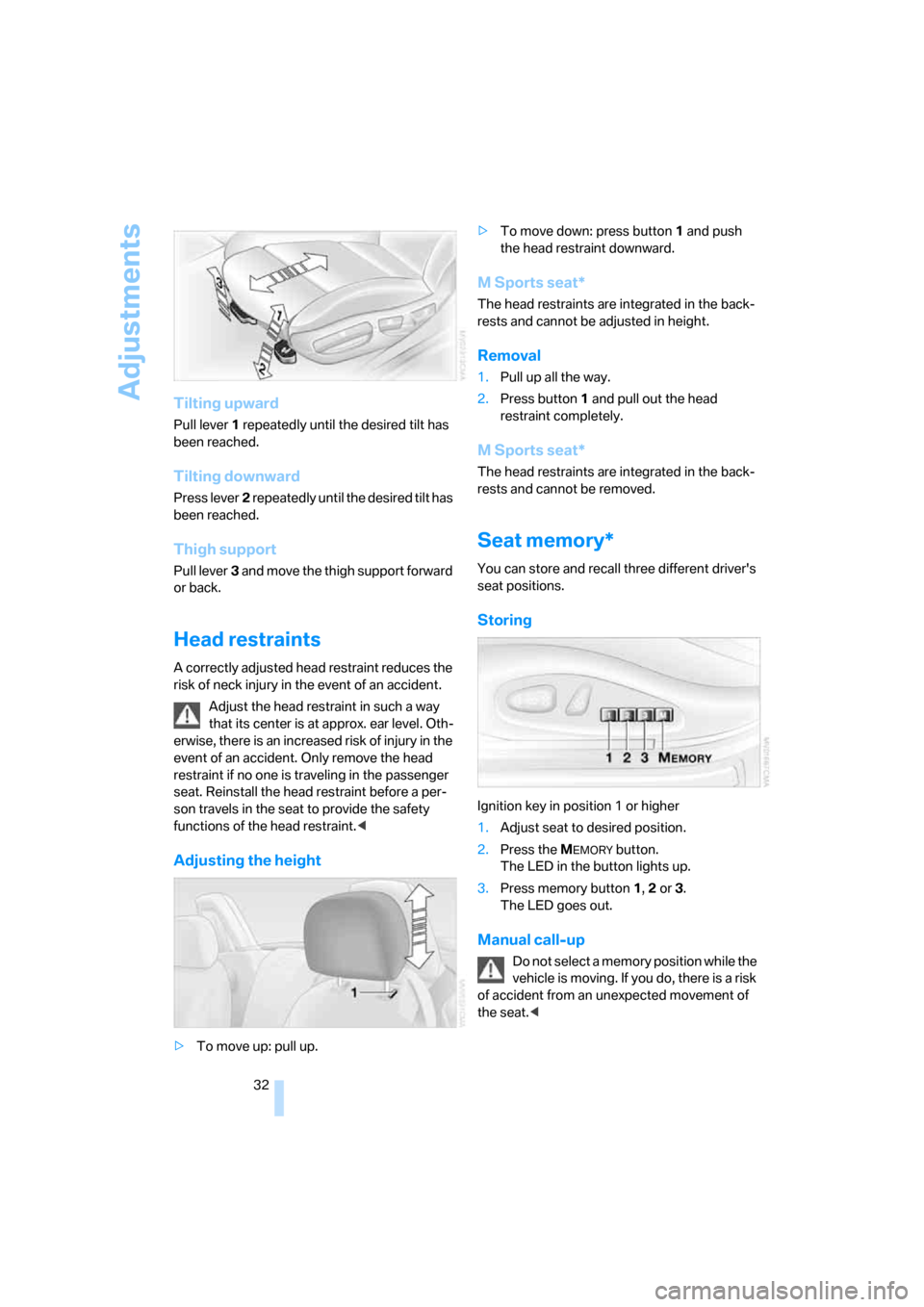
Adjustments
32
Tilting upward
Pull lever1 repeatedly until the desired tilt has
been reached.
Tilting downward
Press lever2 repeatedly until the desired tilt has
been reached.
Thigh support
Pull lever3 and move the thigh support forward
or back.
Head restraints
A correctly adjusted head restraint reduces the
risk of neck injury in the event of an accident.
Adjust the head restraint in such a way
that its center is at approx. ear level. Oth-
erwise, there is an increased risk of injury in the
event of an accident. Only remove the head
restraint if no one is traveling in the passenger
seat. Reinstall the head restraint before a per-
son travels in the seat to provide the safety
functions of the head restraint.<
Adjusting the height
>To move up: pull up.>To move down: press button1 and push
the head restraint downward.
M Sports seat*
The head restraints are integrated in the back-
rests and cannot be adjusted in height.
Removal
1.Pull up all the way.
2.Press button1 and pull out the head
restraint completely.
M Sports seat*
The head restraints are integrated in the back-
rests and cannot be removed.
Seat memory*
You can store and recall three different driver's
seat positions.
Storing
Ignition key in position 1 or higher
1.Adjust seat to desired position.
2.Press the M
EMORY button.
The LED in the button lights up.
3.Press memory button 1, 2 or 3.
The LED goes out.
Manual call-up
Do not select a memory position while the
vehicle is moving. If you do, there is a risk
of accident from an unexpected movement of
the seat.<
Page 35 of 132
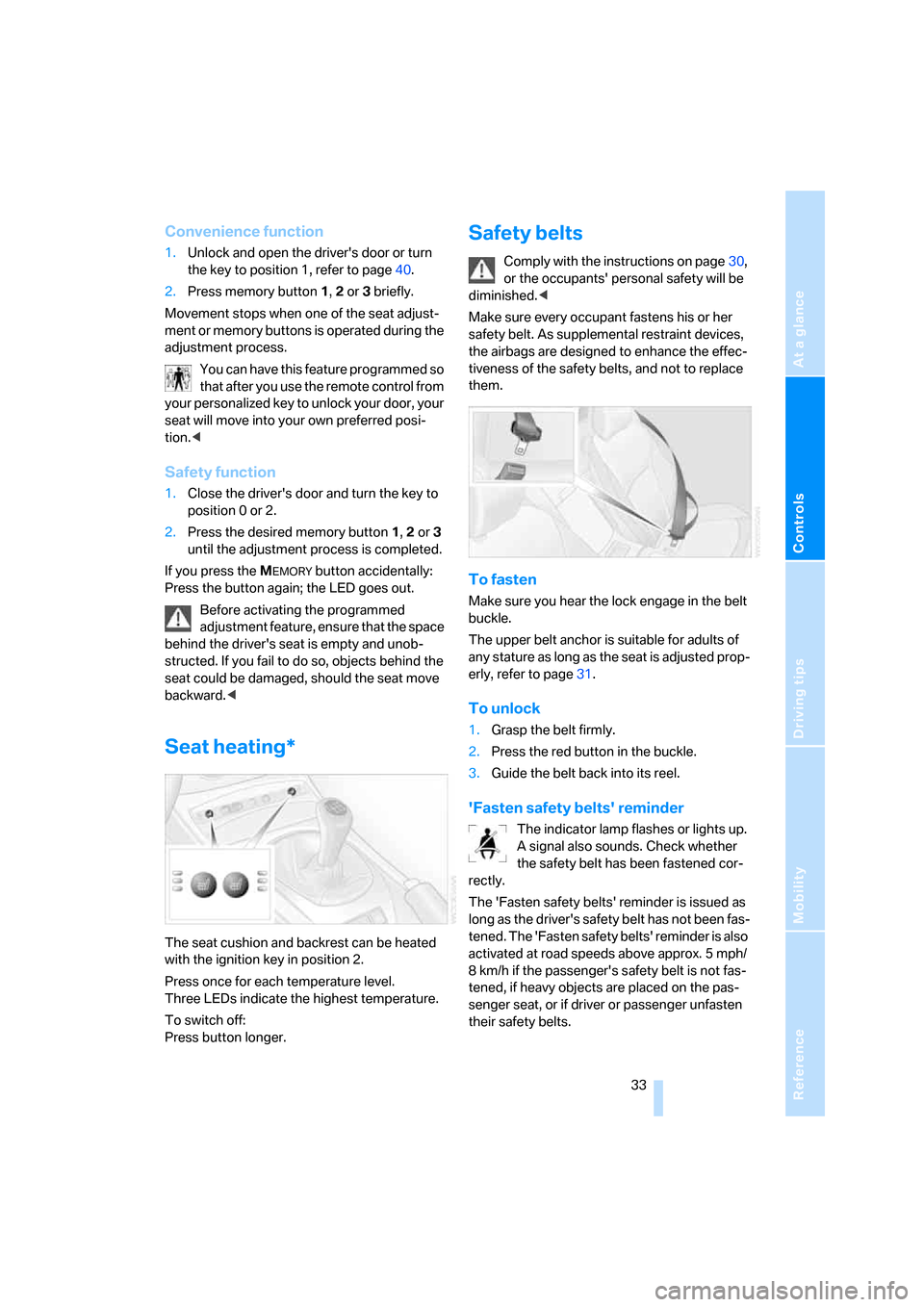
Reference
At a glance
Controls
Driving tips
Mobility
33
Convenience function
1.Unlock and open the driver's door or turn
the key to position 1, refer to page40.
2.Press memory button 1, 2 or 3 briefly.
Movement stops when one of the seat adjust-
ment or memory buttons is operated during the
adjustment process.
You can have this feature programmed so
that after you use the remote control from
your personalized key to unlock your door, your
seat will move into your own preferred posi-
tion.<
Safety function
1.Close the driver's door and turn the key to
position 0 or 2.
2.Press the desired memory button 1, 2 or 3
until the adjustment process is completed.
If you press the M
EMORY button accidentally:
Press the button again; the LED goes out.
Before activating the programmed
adjustment feature, ensure that the space
behind the driver's seat is empty and unob-
structed. If you fail to do so, objects behind the
seat could be damaged, should the seat move
backward.<
Seat heating*
The seat cushion and backrest can be heated
with the ignition key in position 2.
Press once for each temperature level.
Three LEDs indicate the highest temperature.
To switch off:
Press button longer.
Safety belts
Comply with the instructions on page30,
or the occupants' personal safety will be
diminished.<
Make sure every occupant fastens his or her
safety belt. As supplemental restraint devices,
the airbags are designed to enhance the effec-
tiveness of the safety belts, and not to replace
them.
To fasten
Make sure you hear the lock engage in the belt
buckle.
The upper belt anchor is suitable for adults of
any stature as long as the seat is adjusted prop-
erly, refer to page31.
To unlock
1.Grasp the belt firmly.
2.Press the red button in the buckle.
3.Guide the belt back into its reel.
'Fasten safety belts' reminder
The indicator lamp flashes or lights up.
A signal also sounds. Check whether
the safety belt has been fastened cor-
rectly.
The 'Fasten safety belts' reminder is issued as
long as the driver's safety belt has not been fas-
tened. The 'Fasten safety belts' reminder is also
activated at road speeds above approx. 5 mph/
8 km/h if the passenger's safety belt is not fas-
tened, if heavy objects are placed on the pas-
senger seat, or if driver or passenger unfasten
their safety belts.
Page 36 of 132
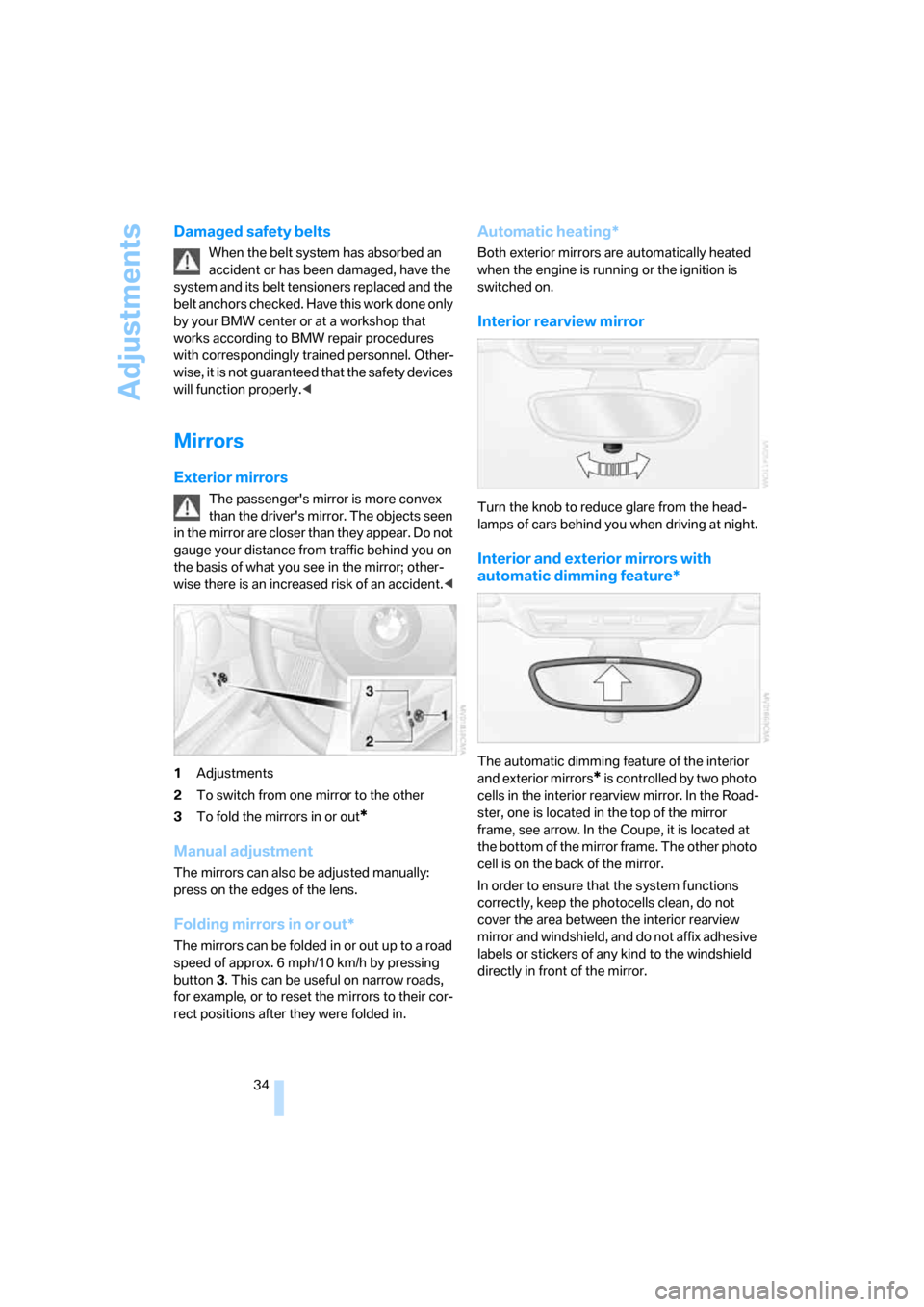
Adjustments
34
Damaged safety belts
When the belt system has absorbed an
accident or has been damaged, have the
system and its belt tensioners replaced and the
b e l t a n c h o r s c h e c k e d . H a v e t h i s w o r k d o n e o n l y
by your BMW center or at a workshop that
works according to BMW repair procedures
with correspondingly trained personnel. Other-
wise, it is not guaranteed that the safety devices
will function properly.<
Mirrors
Exterior mirrors
The passenger's mirror is more convex
than the driver's mirror. The objects seen
in the mirror are closer than they appear. Do not
gauge your distance from traffic behind you on
the basis of what you see in the mirror; other-
wise there is an increased risk of an accident.<
1Adjustments
2To switch from one mirror to the other
3To fold the mirrors in or out
*
Manual adjustment
The mirrors can also be adjusted manually:
press on the edges of the lens.
Folding mirrors in or out*
The mirrors can be folded in or out up to a road
speed of approx. 6 mph/10 km/h by pressing
button3. This can be useful on narrow roads,
for example, or to reset the mirrors to their cor-
rect positions after they were folded in.
Automatic heating*
Both exterior mirrors are automatically heated
when the engine is running or the ignition is
switched on.
Interior rearview mirror
Turn the knob to reduce glare from the head-
lamps of cars behind you when driving at night.
Interior and exterior mirrors with
automatic dimming feature*
The automatic dimming feature of the interior
and exterior mirrors
* is controlled by two photo
cells in the interior rearview mirror. In the Road-
ster, one is located in the top of the mirror
frame, see arrow. In the Coupe, it is located at
the bottom of the mirror frame. The other photo
cell is on the back of the mirror.
In order to ensure that the system functions
correctly, keep the photocells clean, do not
cover the area between the interior rearview
mirror and windshield, and do not affix adhesive
labels or stickers of any kind to the windshield
directly in front of the mirror.
Page 37 of 132
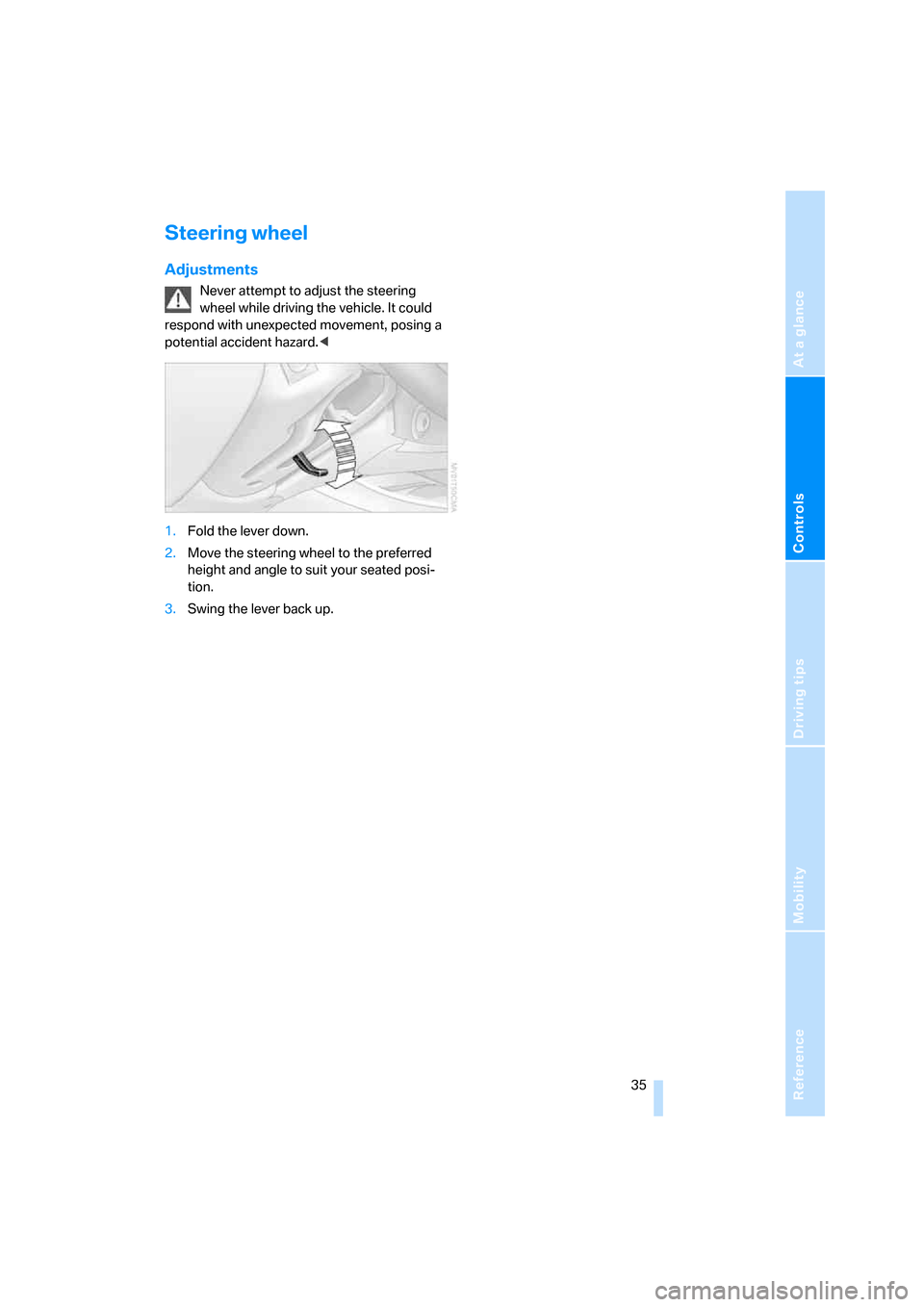
Reference
At a glance
Controls
Driving tips
Mobility
35
Steering wheel
Adjustments
Never attempt to adjust the steering
wheel while driving the vehicle. It could
respond with unexpected movement, posing a
potential accident hazard.<
1.Fold the lever down.
2.Move the steering wheel to the preferred
height and angle to suit your seated posi-
tion.
3.Swing the lever back up.
Page 38 of 132
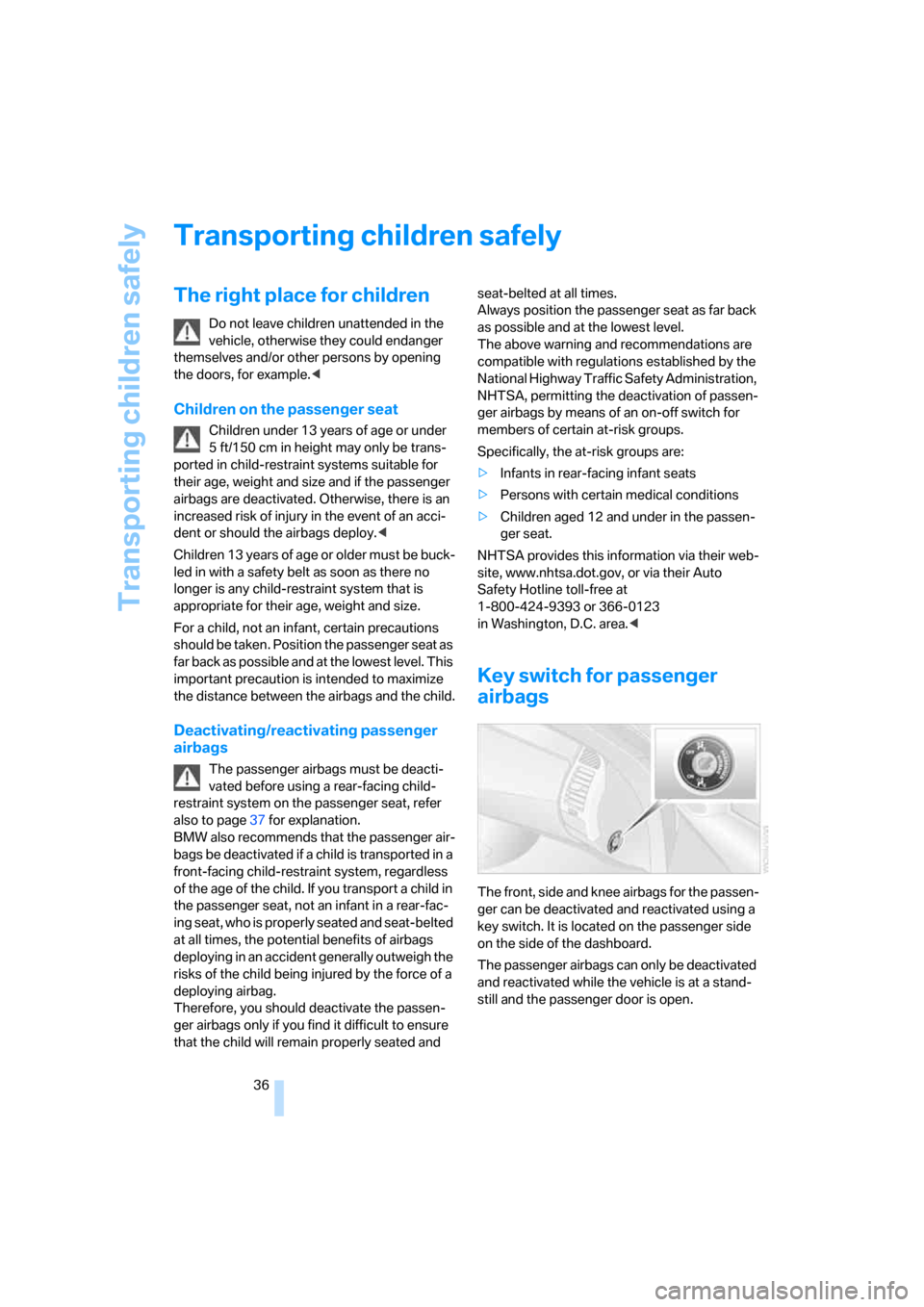
Transporting children safely
36
Transporting children safely
The right place for children
Do not leave children unattended in the
vehicle, otherwise they could endanger
themselves and/or other persons by opening
the doors, for example.<
Children on the passenger seat
Children under 13 years of age or under
5 ft/150 cm in height may only be trans-
ported in child-restraint systems suitable for
their age, weight and size and if the passenger
airbags are deactivated. Otherwise, there is an
increased risk of injury in the event of an acci-
dent or should the airbags deploy.<
Children 13 years of age or older must be buck-
led in with a safety belt as soon as there no
longer is any child-restraint system that is
appropriate for their age, weight and size.
For a child, not an infant, certain precautions
should be taken. Position the passenger seat as
far back as possible and at the lowest level. This
important precaution is intended to maximize
the distance between the airbags and the child.
Deactivating/reactivating passenger
airbags
The passenger airbags must be deacti-
vated before using a rear-facing child-
restraint system on the passenger seat, refer
also to page37 for explanation.
BMW also recommends that the passenger air-
bags be deactivated if a child is transported in a
front-facing child-restraint system, regardless
of the age of the child. If you transport a child in
the passenger seat, not an infant in a rear-fac-
ing seat, who is properly seated and seat-belted
at all times, the potential benefits of airbags
deploying in an accident generally outweigh the
risks of the child being injured by the force of a
deploying airbag.
Therefore, you should deactivate the passen-
ger airbags only if you find it difficult to ensure
that the child will remain properly seated and seat-belted at all times.
Always position the passenger seat as far back
as possible and at the lowest level.
The above warning and recommendations are
compatible with regulations established by the
National Highway Traffic Safety Administration,
NHTSA, permitting the deactivation of passen-
ger airbags by means of an on-off switch for
members of certain at-risk groups.
Specifically, the at-risk groups are:
>Infants in rear-facing infant seats
>Persons with certain medical conditions
>Children aged 12 and under in the passen-
ger seat.
NHTSA provides this information via their web-
site, www.nhtsa.dot.gov, or via their Auto
Safety Hotline toll-free at
1-800-424-9393 or 366-0123
in Washington, D.C. area.<
Key switch for passenger
airbags
The front, side and knee airbags for the passen-
ger can be deactivated and reactivated using a
key switch. It is located on the passenger side
on the side of the dashboard.
The passenger airbags can only be deactivated
and reactivated while the vehicle is at a stand-
still and the passenger door is open.
Page 39 of 132
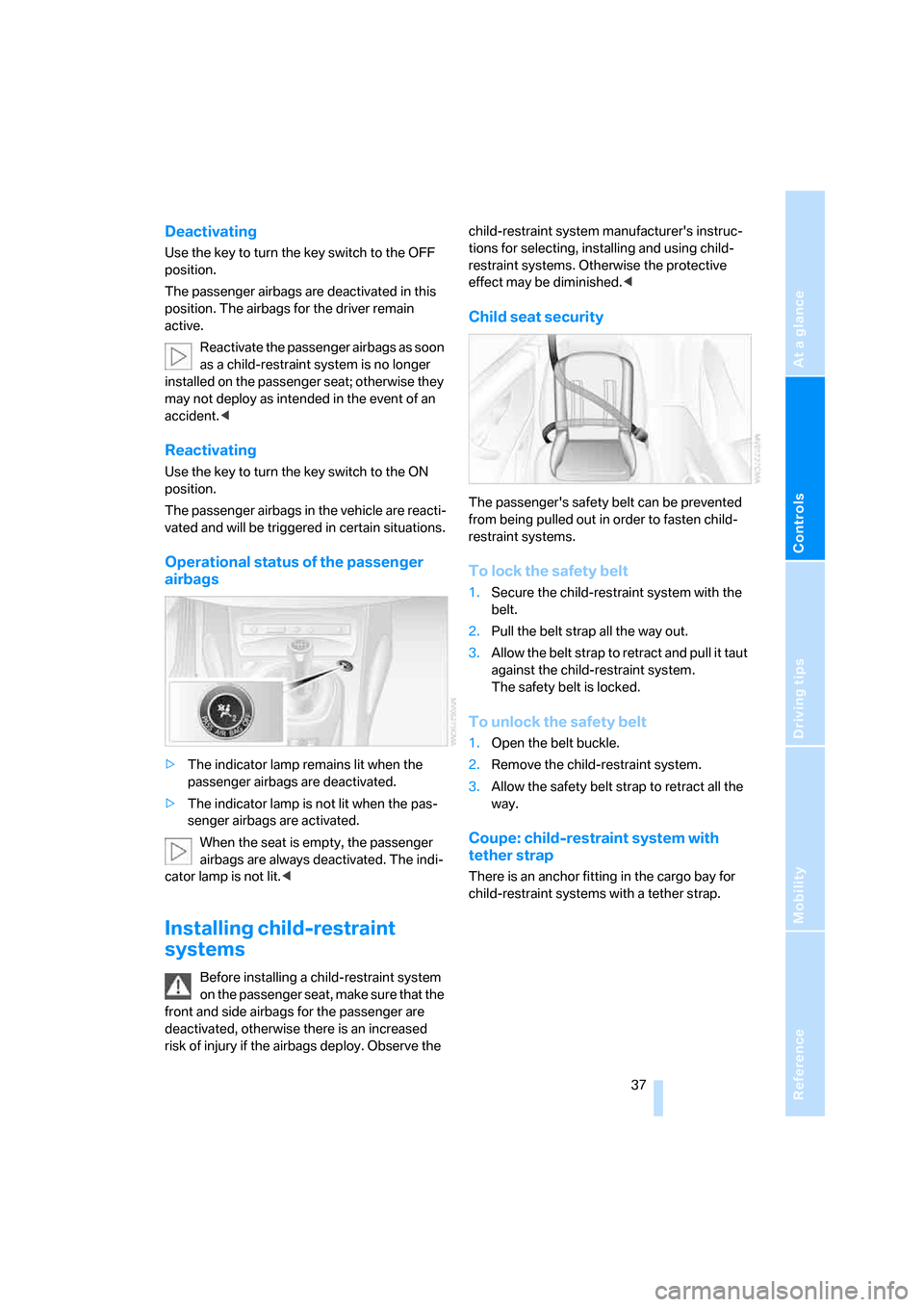
Reference
At a glance
Controls
Driving tips
Mobility
37
Deactivating
Use the key to turn the key switch to the OFF
position.
The passenger airbags are deactivated in this
position. The airbags for the driver remain
active.
Reactivate the passenger airbags as soon
as a child-restraint system is no longer
installed on the passenger seat; otherwise they
may not deploy as intended in the event of an
accident.<
Reactivating
Use the key to turn the key switch to the ON
position.
The passenger airbags in the vehicle are reacti-
vated and will be triggered in certain situations.
Operational status of the passenger
airbags
>The indicator lamp remains lit when the
passenger airbags are deactivated.
>The indicator lamp is not lit when the pas-
senger airbags are activated.
When the seat is empty, the passenger
airbags are always deactivated. The indi-
cator lamp is not lit.<
Installing child-restraint
systems
Before installing a child-restraint system
on the passenger seat, make sure that the
front and side airbags for the passenger are
deactivated, otherwise there is an increased
risk of injury if the airbags deploy. Observe the child-restraint system manufacturer's instruc-
tions for selecting, installing and using child-
restraint systems. Otherwise the protective
effect may be diminished.<
Child seat security
The passenger's safety belt can be prevented
from being pulled out in order to fasten child-
restraint systems.
To lock the safety belt
1.Secure the child-restraint system with the
belt.
2.Pull the belt strap all the way out.
3.Allow the belt strap to retract and pull it taut
against the child-restraint system.
The safety belt is locked.
To unlock the safety belt
1.Open the belt buckle.
2.Remove the child-restraint system.
3.Allow the safety belt strap to retract all the
way.
Coupe: child-restraint system with
tether strap
There is an anchor fitting in the cargo bay for
child-restraint systems with a tether strap.
Page 40 of 132
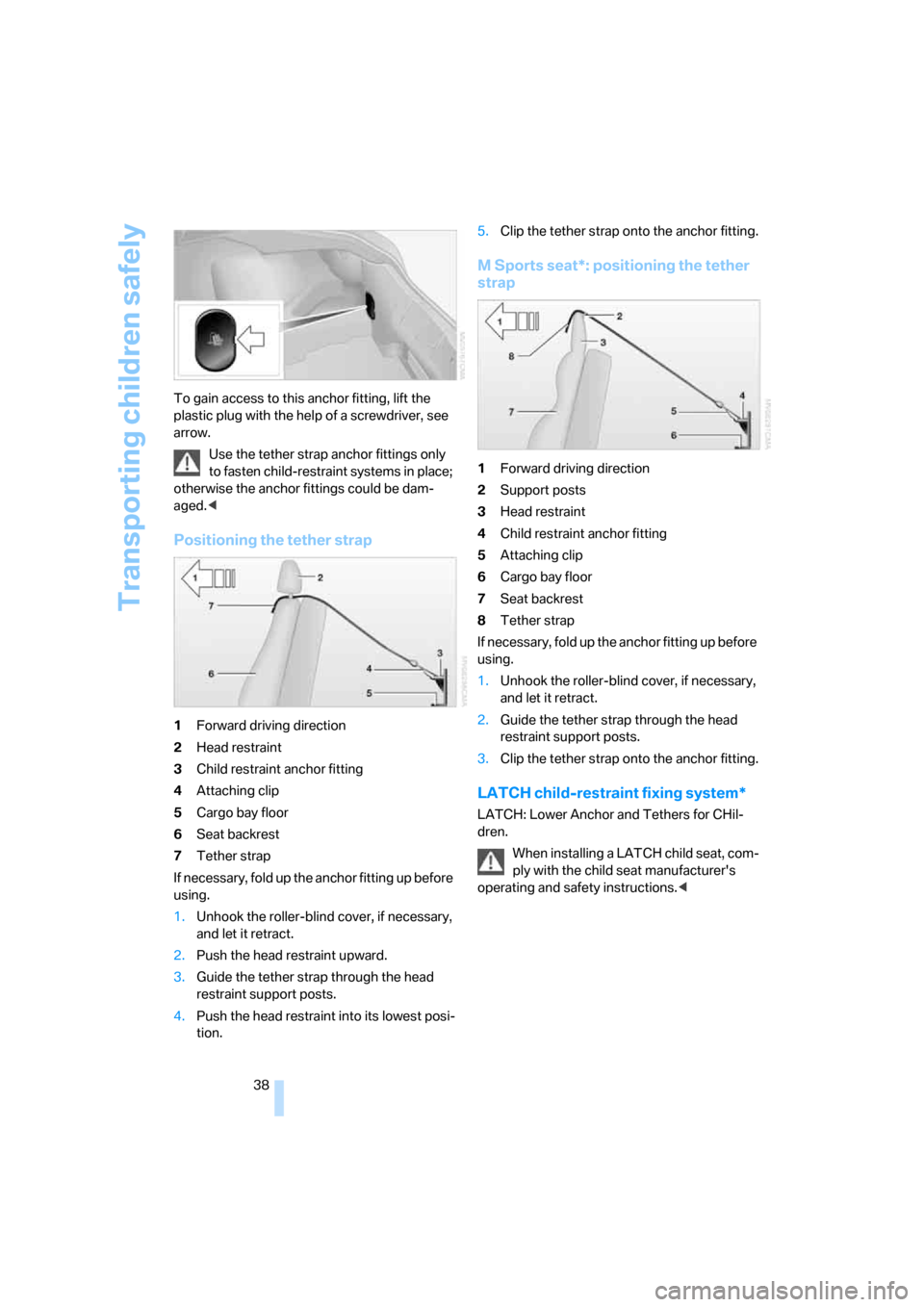
Transporting children safely
38 To gain access to this anchor fitting, lift the
plastic plug with the help of a screwdriver, see
arrow.
Use the tether strap anchor fittings only
to fasten child-restraint systems in place;
otherwise the anchor fittings could be dam-
aged.<
Positioning the tether strap
1Forward driving direction
2Head restraint
3Child restraint anchor fitting
4Attaching clip
5Cargo bay floor
6Seat backrest
7Tether strap
I f n ec e s s a r y, f o l d up t h e a n ch o r f it t i n g up b e f o r e
using.
1.Unhook the roller-blind cover, if necessary,
and let it retract.
2.Push the head restraint upward.
3.Guide the tether strap through the head
restraint support posts.
4.Push the head restraint into its lowest posi-
tion.5.Clip the tether strap onto the anchor fitting.
M Sports seat*: positioning the tether
strap
1Forward driving direction
2Support posts
3Head restraint
4Child restraint anchor fitting
5Attaching clip
6Cargo bay floor
7Seat backrest
8Tether strap
I f n ec e s s a r y, f o l d up t h e a n ch o r f it t i n g up b e f o r e
using.
1.Unhook the roller-blind cover, if necessary,
and let it retract.
2.Guide the tether strap through the head
restraint support posts.
3.Clip the tether strap onto the anchor fitting.
LATCH child-restraint fixing system*
LATCH: Lower Anchor and Tethers for CHil-
dren.
When installing a LATCH child seat, com-
ply with the child seat manufacturer's
operating and safety instructions.<